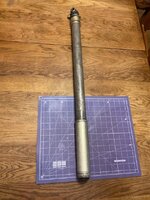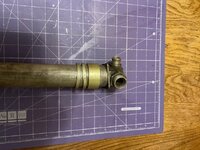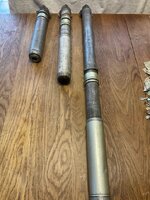Deleted member 68059
Staff Sergeant
- 1,056
- Dec 28, 2015
Whoever cut that piston up is definetly going to at least Dante`s 6th circle right off the bat.So, yes, a Jumo 222 A/B piston. I never thought I would see one but, this was advertised a few years ago without identification and I bought it. You might not be able to read all the stamped info on the face but the long line says, 222.242 001 f FLUG-ABT.IFA- xx
That is the Junkers part number, followed by a small f then the aircraft parts works abbreviated name. The marks x x are a Junkers symbol with the number 53 which is a Junkers QA stamp, and a lozenge shape with the number 17 inside which is a BAL ministry approval stamp. The weight 1253 (grammes) is stamped at the top and the machined finished size of 134.74mm is stamped on the LH top face, but difficult to see on pic. These pistons have a mirrored pocket for the large single exhaust valve edge because some of the cylinders had exhaust on the RHS, some on the LHS.
The engine was a 2,500hp class but, it never made production, despite possibly being ready, or politics stopping it. The A/B engines were discontinued from development in about 1942 and it is likely that they were all reduced-to-produce. I do not believe a 222 A/B exists today, although there is a later one in the museum at Munich.
Eng



